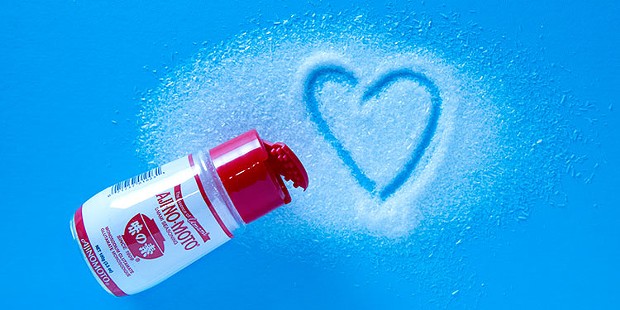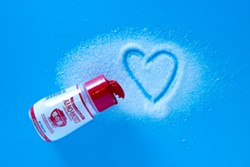[
{
"name": "Top Stories Video Pair",
"insertPoint": "7",
"component": "17087298",
"parentWrapperClass": "fdn-ads-inline-content-block",
"requiredCountToDisplay": "1"
}
]
They're not like salt crystals, exactly. They're longer, like white bugle beads from a glamorous 1920s dress. In a pile, they sparkle like dreamy snow in a stop-motion Christmas movie. And when judiciously added to food, they're goddamn magic.
Monosodium glutamate, or MSG, is much maligned, right up there with high fructose corn syrup and trans fats as an evil, unhealthy additive that makes us sick. But MSG is a naturally occurring compound found, for example, in tomatoes and some cheeses. More than 100 years ago, Japanese chemist Kikunae Ikeda figured out how to draw the rich, satisfying umami flavor of glutamic acid, a common amino acid, from kombu seaweed and bond it to salt. And so monosodium glutamate in a bottle was born. Pour out some instant ramen broth for the man.
Umami, that buzz word on every chef's tongue, describes the rounded, satisfying flavor in foods, the depth that, say, anchovies and Parmesan give Caesar salad, the earthy richness of mushrooms, meat's, well, meatiness (think unsalted stock). It's a recognized basic flavor, too, right along with sweet, salty, bitter and sour. But since MSG powder is an artificially produced shortcut — a sprinkle replacing those hours of stock boiling time — with a scientific name, many believe it's unhealthy and/or semi-poisonous. (Shhh, MSG. Don't listen to them, baby.) This despite the fact that, according to the Food and Drug Administration, "MSG is produced by the fermentation of starch, sugar beets, sugar cane or molasses. This fermentation process is similar to that used to make yogurt, vinegar and wine."
Used in reasonable amounts as a seasoning, it's fine. Despite anecdotal reports of MSG's side effects — a combination of sluggishness, headaches, numbness and palpitations that used to be called "Chinese Restaurant Syndrome" (not cool, man) — research has shown little hard evidence. In a study published in the journal Food and Chemical Toxicology, double-blind tests showed the same rate of symptoms with MSG and a placebo. An FDA study found that some people experienced symptoms after consuming 3 grams or more with water, an amount it deemed "unlikely." (The agency also ditched the pejorative name for the symptoms.) In fact, the FDA website states most MSG-spiked meals hover around .5 grams, so that headache you got might be from drinking too much Tsing Tao or all the sugar in your sweet and sour, even if you are one of those sensitive types.
As for the Chinese restaurants people regard with such suspicion, they're not the only places you'll find human-made MSG. That psychedelic orange dust on your Doritos is full of it. Maybe you're not your best after plowing through a bag but is anybody complaining about Extreme Nacho Syndrome? MSG shows up in ranch dressing, fast food fried chicken (that's right, the least Chinese man to ever front a restaurant, the Colonel, is pouring the finger-lickin' stuff on) and plenty of other foods. And if you've ever made a recipe that calls for a pinch of Aji-no-moto, well, that's MSG in that little red and white bottle. No shame. My family sprinkled it in scrambled eggs.
Mind you, some cooks use it as a kind of duct tape (the Colonel could ease up, truthfully), the quick and dirty solution to a flavorless dish, much like throwing hot sauce or salt at a problem. But MSG's flavor pumping effect is something that many of us have come to expect, like HDTV, even when the sharpness gets creepy.
The last time I was in San Francisco Airport, friends I was visiting asked me to pick up an order of beef chow fun with no MSG from their favorite takeout stand. They'd gotten it there before, no problem, they said. But when I placed my order, the woman behind the counter frowned like an auntie tasked with delivering bad news and said no.
She waved me over to the side and glanced back at the kitchen. "Everybody has it," she whispered, explaining that while the chef doesn't sprinkle the stuff on, plenty of Asian kitchen staples, like oyster sauce and bouillon, come standard with MSG. "If somebody tells you there's no MSG, they lie. Or they don't know." It was a hard truth and I was both grateful and disoriented by the sudden intimacy of a shared secret.
Surely there are exceptions. But the labor it would take to make those staple ingredients from scratch isn't something most people are willing to pay (or wait) for, at least not at notoriously underpriced Asian restaurants. And let's not forget that naturally occurring MSG — do you even want to go to an Italian place without tomatoes and Parmesan cheese?
I thanked my new airport restaurant confidant and got the fried noodles to go anyway, along with a couple of dumplings that I ate by my gate. By the time I popped open the takeout container they were a slightly droopy from too much time wheeling my baggage through the terminal. Even so, the minced shrimp filling was tender and rich with that comforting umami flavor — slightly artificial but totally honest.
Jennifer Fumiko Cahill is the arts and features editor at the North Coast Journal. Reach her at 442-1400 extension 320 or [email protected] Follow her on Twitter @JFumikoCahill.
Comments (2)
Showing 1-2 of 2
more from the author
-
Look Up for Rooftop Sushi
- Apr 19, 2024
-
Resentencing, CASA Kids and Freaky Fish
- Apr 19, 2024
-
Eco Cemeteries, Flags, Impacts and Foods
- Apr 12, 2024
- More »


































